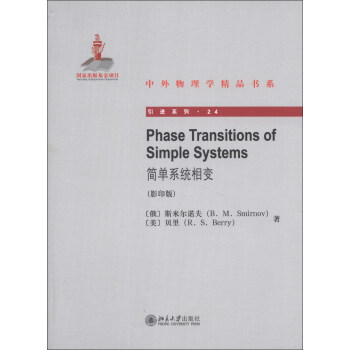精彩书摘:
Thus this example demonstrates how it is that the potential energy surface has many local minima in a space of atomic coordinates, and these local minima are separated by barriers with saddle points in this space. Therefore excited configurational states are locally stable states, and a cluster can remain enough long in a specific excited configurational state to equilibrate its vibrations. Hence, if the ground configuration state is the basis for the solid cluster state, we can anticipate that configurationally excited states can be a basis for the liquid aggregate state. 1.5 Voids as Elementary Configurational ExcitationsOne can consider the example just given of a configurational excitation of a cluster of 13 atoms as an elementary configurational excitation. In this case a vacancy or hole is formed in the surface cluster shell, and this vacancy is deformed due to interaction of surrounding atoms. Let us widen this example and consider a very large regular surface whose configurational excitation results in passage of some atoms from the surface layer to positions on the surface. In contrast to the previous example of the 13-atom cluster, several or many elementary configurational excitations of this kind can characterize the total configurational excitation. In the same manner, one can consider internal excitations of a large or bulk crystal if internal atoms are removed onto the surface of this crystal. So long as we remove only atoms which do not neighbor one another, the total energy of this configurational excitation is simply a sum of the excitation energies for individual vacancies. In this
way, representing the total configurational excitation as a sum of elementary configurational excitations, we pass from a dynamic description of the system to its statistical description.
So long as vacancies do not border one another, the energy of formation of an elementary vacancy is determined by the number of bonds for a removed atom. Because we consider atomic ensembles in which interaction between nearest neighbors is dominant, this number of bonds equals 12. When this condition is not fulfilled, we take a void [45] or empty internal space as an elementary configurational excitation of an ensemble of bound classical particles, considering a void as a perturbed (or relaxed) vacancy. But in contrast to a vacancy in a bulk solid, a void has an indefinite volume and shape that change in time. Therefore from the standpoint of saddle-crossing dynamics, each configurationally excited state corresponds to a certain number of voids which are identical on average.
……
内容简介:
《中外物理学精品书系·引进系列(24):简单系统相变(影印版)》内容丰富,涵盖面广,可读性强,其中既有对我国传统物理学发展的梳理和总结,也有对正在蓬勃发展的物理学前沿的全面展示;既引进和介绍了世界物理学研究的发展动态,也面向国际主流领域传播中国物理的优秀专著。
目录:
Introduction
Part I Thermodynamics of Ensembles of Classical Particles
1 Excitations in Simple Atomic Ensembles
1.1 Thermodynamics and Dynamics of Particle Ensembles
1.2 Interaction of Inert Gas Atoms
1.3 Similarity Law for Simple Atomic Ensembles
1.4 Evolution of Particle Ensembles
1.5 Voids as Elementary Configurational Excitations
2 Structures of Ensembles of Interacting Particles
2.1 Close-Packed Structures
2.2 Shells in Close-Packed Structures
2.3 Lennard-Jones Crystal
2.4 Morse Crystal
2.5 Surface Energy of Lennard-Jones and Morse Crystals
2.6 Solid and Liquid Inert Gases Near the Triple Point
3 Thermodynamics of Dense Gases and Liquids
3.1 Equation of State for an Ensemble of Randomly Distributed Particles
3.2 Equilibrium of Gas and Condensed States
3.3 Liquid Surface Parameters
3.4 Peculiarities of Similarity for Inert Gases
3.5 Scaling Law for Molecular Systems
4 Clusters with Short-Range Interaction
4.1 Configurations of Solid Clusterswith Pairwise Atomic Interactions
4.2 Peculiarities of Close-Packed Clusterswith Short-Range Interaction
4.3 Constructing fcc-Clusters with Short-RangeInteraction
4.4 Growth of fcc Clusters with Short-Range Atomic Interaction
4.5 Regular Clusters of Close-Packed Structures
4.6 Icosahedral Clusters
4.7 Competition of Icosahedral and Close-Packed Structures
5 Ensembles of Classical Particles with Repulsion
5.1 Thermodynamics of Ensembles of Repelling Particles
5.2 A System of Hard Spheres
5.3 Colloid Suspensions as Systems of Repelling Particles
5.4 Virial Theorem and Instability of Crystal Structure
5.5 Phase Transition for an Ensemble of Repelling Atoms
5.6 Phase Transitions in Inert Gases under High Pressure
5.7 Structures of an Ensemble of Repelling Particles at Low Temperatures
Part II Configurational Excitations and Aggregate Statesof Ensembles of Classical Particles
6 Configurational Excitation and Voids in Ensemblesof Bound Classical Atoms
6.1 Separation of Thermal and Configurational Degreesof FYeedom of Clusters
6.2 Lattice Model for the Order-Disorder Phase Transition
6.3 Chemical Equilibria and Phase Transitions
6.4 Internal Voids in a System of Identical Particles
6.5 Void Formation in Two Dimensions
6.6 The Cell Model for Disk Particles
6.7 Peculiarities of Configurational Excitation for Bulk Atomic Systems
6.8 Two-State Approximation for Aggregate States
7 Configurational Cluster Excitation with Pairwise Interactions
7.1 Peculiarities of Configurational Excitation of Clusters
7.2 Structural Phase Transition in a Solid Cluster
7.3 Configurational Excitation of the Icosahedral Cluster of 13 Atoms
7.4 The Cluster as a Microcanonical Ensemble of Bound Atoms
7.5 The Cluster as a Canonical Ensemble of Bound Atoms
……
Part III Dynamics of Configurational Excitations in Ensemblesof Classical Particles




好评度